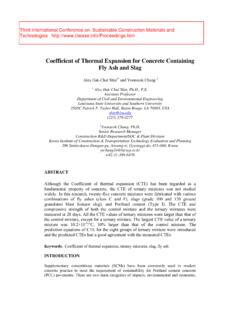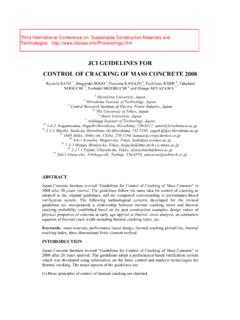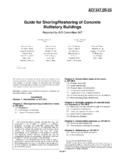Transcription of Compressive strength of concrete after early loading
1 Compressive strength of concreteafter early loading &1 Peter ClaisseMA,PhD,CEng,FICEP rofessor of Construction Materials, Faculty of Engineering andComputing, Coventry University, Coventry, UK&2 Christopher DeanMScPostgraduate Student, Faculty of Engineering and Computing,Coventry University, Coventry, UK12In modern construction projects it is necessary to work with concrete at a time before its strength can be fullydeveloped. Applying large construction loads to a structure can lead to a reduction in strength if the serviceabilitylimit has been exceeded. However, the effects of smaller Compressive loading on concrete cubes, below theserviceability limit state, have been found to have a positive impact on the 28 day ultimate strength . The results fromthis study indicate the 28 day strength of wet cured concrete cubes increased on average by 6% when specimens wereloaded up to 90% of their ultimate strength at 1, 3 or 7 days after casting.
2 concrete specimens under the sameconditions loaded past the point of maximum stress at an early age displayed a reduction in strength from 5% orgreater, depending upon the extent of the loading . This phenomenon of increased strength after loading andsubsequent curing has been reported in the literature for many years, but the use of modern Compressive testapparatus has enabled the present authors to show that the final strength has a high level of correlation with thedisplacement during the initial early loading . The experiments carried out in the present study were to simulate highconstruction loading at early ages to better understand the effects of early loading and the changes in ultimatestrength at later IntroductionConstruction loading is often the most intensive stage of astructure s life, with the concrete still in its early stages ofstrength development it is essential to ensure it is notoverloaded.
3 Premature removal of formwork, lifting or movingof precast concrete or large construction live loads can causecracking or other damage (Kaminetzky and Stivaros, 1994).Even if a structure does not collapse during the constructionstage, it is possible to damage it and reduce its strength . Theaim of this study was to examine the effects of compressiveloading of concrete at stages typical in the use of the shoring/reshoring technique, widely used in concrete floor constructionin multi-storey buildings, where concrete can undergo largecompressive strengths soon after this study, 100 mm concrete cubes were compressed to loadsof 70, 80 and 90% of their ultimate strength to simulate earlyoverloading at 1, 3 and 7 days after casting, which is typical ofearly stages in construction of concrete structures.
4 Thesespecimens were reloaded at 28 days after being wet cured underlaboratory conditions. Comparing the results from earlyloaded specimens and control specimens, an increase instrength was recorded for most, although not all study went on to further examine the relationship betweenthe increase in strength and initial loadings of specimens andfound some correlation between the initial displacements ofspecimens and the gain in minor gain in strength can give confidence to designersand contractors, because it shows that early loading is not asdamaging as they might have expected. The authors are not,however, suggesting that the observed additional strengthshould be relied upon in designs or that deliberate early loadingshould be used to try to obtain phenomenon was also found in the literature in similarstudies of sustained biaxial loading , long-term creep and re-testing loaded specimens over different periods.
5 The results ofConstruction MaterialsCompressive strength of concrete afterearly loadingClaisse and DeanProceedings of the Institution of Civil 1100057 Received 12/10/2011 Accepted 03/01/2012 Keywords: concrete structures/ concrete technology andmanufacture/ strength and testing of materialsice|proceedingsICE Publishing: All rights reserved1wet-cured specimens from a published paper were recalculatedto find a similar result to the one found Literature reviewConcrete under uniaxial loading will develop cracks parallel tothe direction loaded. Under uniaxial loading from 30% toaround 70% of maximum stress, the concrete will undergo slowcrack propagation. At between 70 and 90%, cracks will beginto increase noticeably (Santiago and Hilsdorf, 1973). Finecracks that have been created in fractured concrete are capableof complete recovery under moist conditions; this is aided bythe formation of insoluble calcium carbonate from the calciumhydroxide in hydrated cement (Neville, 1994).
6 The process ofcracked concrete undergoing self-repair is known as auto-geneous earlier studies, the phenomenon of autogeneous healingwas found to heal cracked specimens to strengths almost equalto unloaded specimens, provided the specimens were not badlyshattered and were subject to continuous moist curing (Gilkey,1926). Autogeneous healing was first recognised by Abrams in1913 (Whitlam, 1954) where cracks disappeared in a highwaybridge 3 years after their appearance. To quantify autogeneoushealing, reloading times have ranged from 3 days to 10 years ina range of different studies since its discovery. In 1950 a studyof 10?5 year old concrete specimens under sustained creepconditions were reloaded to examine the effects of long-termcreep (Washa and Fluck, 1950).
7 Reloaded specimens displayed about 5% higher [ Compressive strength ] for hand-roddedconcrete, than that of companion unloaded cylinders .Abdel-Jawad and Haddad (1992) carried out tests which weresimilar to those reported here and concluded that loadingconcrete, beyond 8 h of casting, up to 90% of its compressivestrength [at time of loading ] has no effect on the strength ofconcrete at a later age . loading concrete past maximum stress( to failure) resulted in a strength loss of from 10 to 50%,depending on the age at time of loading , the age at time of re-testing and the curing re-examination by the present authors of the researchdone by Abdel-Jawad and Haddad (1992) in which 900specimens were loaded 8 to 72 h after casting, and reloadedbetween 7 and 90 days, it was found that under certainconditions the crushed specimens displayed greater strengthdevelopment against specimens not previously loaded.
8 Theexperiment focused on re-testing concrete with different water/cement (w/c) ratios at 7, 28 and 90 days under both wet and dryconditions. Figure 1 is taken from their data collected for wetcured specimens with a w/c ratio of 0?7 showing the the conditions of: (1) initial loading taking place after8 h of casting; (2) the load being less than 100%; and (3) the ageof re-testing being 28 days, it was found that the majority ofspecimens displayed a substantial increase in strength aver-aging 5?7% above that of the control strength (Figure 2). Thisdoes not conform to typical theoretical models regardingautogeneous healing of specimens, where specimens are onlyexpected to regain up to their original strength (Neville, 1994).Coutinho (1977) suggested this is due to a factor of creep; pressure, like temperature, influences chemical reactions,particularly the reaction of the cement components with pressure to which cement components are submittedincreases their solubility in the water with which they are incontact, thus increasing the hydration of cement.
9 It has alsobeen suggested that this increase in strength is greater whenapplied to younger age concrete for longer durations ofloading, although it has been noted by Coutinho that theincrease in Compressive strength does not exceed 15%.A study from 2002 (Liuet al., 2002) in which crack restorationunder sustained biaxial compression (30% of ultimate strengthover period of 14 days) also found this phenomenon ofincreased strength for specimens subject to compressiveloading. It was concluded that, concrete creep deformationswill not definitely cause damage of the material. On thecontrary, the sustained compression load at an early age canincrease the strength . Similarly to work done by Abdel-Jawadand Haddad (1992) the increase in strength was mostprominent around 4 weeks after casting, becoming lessprominent at later ages.
10 Results from their study also indicatethat sustained biaxial loading caused greater strength increasethan uniaxial loading alone (Table 1).3. Experimental procedureCement class CEMII/A LL to BS EN197 (BSI, 2000)was used to create three different mix designs with 10 mmuncrushed stone and fine crushed aggregate 50% passingthrough the 600mm sieve (Table 2).The 100 mm concrete cubes were made to BS 8500-1:2006(BSI, 2006) and tested to BS EN 12390-3-2009 (BSI, 2009) at 1,3 and 7 days up to their designated loads of 90, 80 and 70% ofthe ultimate load. An average of two control specimens wereused for each variable to find the relevant percentage ofultimate loading for the test. Two replicate specimens pervariable were loaded up to their relevant values at a uniformrate of 0?



